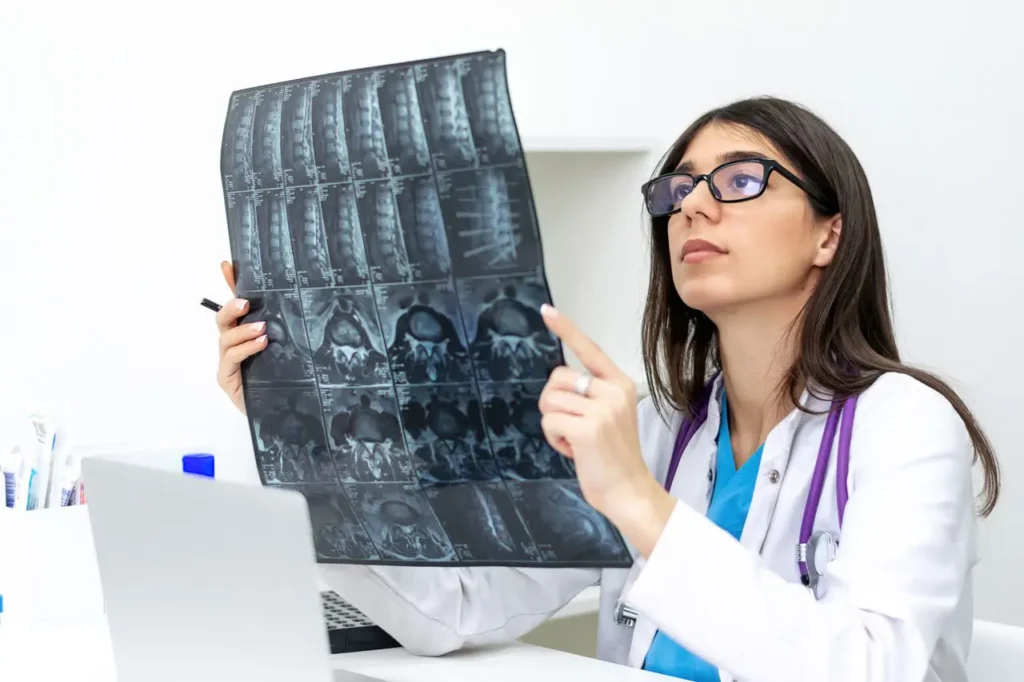Introduction
Disc desiccation is a commonplace circumstance that impacts the intervertebral discs inside the backbone. It is characterized by the dehydration or drying out of those discs, which could cause various signs and symptoms and headaches. In this complete manual, we delve into the intricacies of disc desiccation, its reasons, symptoms and signs, evaluation, treatment options, and preventive measures.
What is disc desperation?
Disc desiccation, additionally known as disc dehydration, takes place while the intervertebral discs lose their water content material, which is essential to a decrease in disc pinnacle and elasticity. These discs act as cushions between the vertebrae, supplying assistance and bearing in mind flexibility inside the backbone. When they dry out, it can result in structural adjustments and aches.
Causes of Disc Desiccation
Several elements can make contributions to the development of disc desiccation:
- Aging: As people age, the discs in their backbones absolutely lose water content and emerge as being at greater risk of desiccation.
- Genetics: Genetic predispositions may want to make a few human beings extra at risk of disc degeneration and desiccation.
- Lifestyle Factors: Poor posture, loss of workout, and excessive weight can boost disc degeneration and dehydration.
- Injury: Trauma or damage to the backbone can harm the intervertebral discs and cause desiccation through the years.
- Smoking: Smoking has been associated with improved disc degeneration, together with desiccation, due to its impact on blood flow and nutrient transport to the discs.
Symptoms of Disc Desiccation
The signs and symptoms of disc desiccation can vary depending on the severity of the circumstance and its location in the spine. Common signs consist of:
- Chronic backache, which may also worsen with motion or extended sitting,.
- Stiffness and reduced flexibility inside the backbone.
- Radiating ache or numbness in the hands or legs if the desiccated disc compresses nearby nerves.
- Muscle susceptible points or tingling sensations in the affected areas.
- Difficulty performing every day sports because of pain and soreness.
Diagnosis
Diagnosing disc desiccation typically includes a mixture of medical facts review, physical exam, and imaging checks. Your healthcare business enterprise can also, moreover:
- Conduct an intensive assessment of your symptoms and clinical information.
- Perform a physical examination to assess your form of movement, reflexes, and muscle power.
- Order imaging checks together with X-rays, MRI (Magnetic Resonance Imaging), or CT (Computed Tomography) scans to visualize the spine and pick out any structural abnormalities, consisting of disc desiccation.
Treatment Options
The treatment approach for disc desiccation wants to alleviate symptoms and signs, enhance backbone characteristics, and save you from similar degeneration. Treatment options might also additionally encompass:
- Pain Management: Over-the-counter or prescription drug treatments can also help alleviate pain and contamination related to disc desiccation.
- Physical Therapy: Targeted sporting occasions and stretches can reinforce the muscle tissues helping the backbone, enhance flexibility, and reduce pain.
- Lifestyle Modifications: Adopting healthy behaviors together with preserving top posture, challenging normal exercise, and keeping off extended sitting or heavy lifting can help save you in addition to causing damage to the discs.
- Injections: Epidural steroid injections or nerve blocks can be advocated to lessen pain and irritation in the affected location.
- Surgery: In severe instances in which conservative treatments fail to offer relief or there’s a lot of nerve compression, surgical interventions, which include discectomy or spinal fusion, may be taken into consideration.
Preventive Measures

While disc desiccation is often part of the herbal getting older technique, positive way of existence changes can help reduce the hazard of developing this circumstance.
- Maintain a healthy weight to reduce extra pressure on the spine.
- Practice authentic posture and ergonomics, especially at the same time as sitting or lifting heavy objects.
- Stay physically lively with everyday workouts to decorate the muscle corpus, assist the backbone, and beautify standard spine health.
- Avoid smoking, as it could boost disc degeneration and desiccation.
- Stay hydrated by ingesting a precise and sufficient amount of water to keep the intervertebral discs hydrated and supple.
Conclusion
Disc desiccation is a not unusual spinal scenario that might cause significant soreness and impairment in our daily lifestyles. While it is often related to growing antiques, manner of life elements and genetic predispositions additionally play a role in its development. Early prognosis and appropriate manipulation are important for minimizing signs and symptoms and stopping, in addition, degeneration of the backbone. By adopting healthy habits and searching for nicely timed medical intervention, human beings can mitigate the effect of disc desiccation on their incredible quality of life and maintain the finest backbone health.
FAQ’s
Frequently Asked Questions (FAQs) about Disc Desiccation
1. What is disc desiccation?
Disc desiccation, also called disc dehydration, is a situation in which the intervertebral discs within the backbone lose their water content material, leading to decreased disc peak and elasticity.
2. What motives disc desiccation?
Several factors can contribute to disc desiccation, including growing older, genetics, lifestyle elements (which include awful posture and absence of exercise), spinal damage, and smoking.
3. What are the symptoms of disc desiccation?
Common symptoms of disc desiccation include a continual decrease in back ache, stiffness, reduced flexibility within the spine, radiating pain or numbness inside the hands or legs, a weak muscle point, and problems acting out every day during sports activities.
4. How is disc desiccation identified?
Diagnosis of disc desiccation generally consists of a scientific data assessment, physical examination, and imaging exams, which include X-rays, MRI (Magnetic Resonance Imaging), or CT (Computed Tomography) scans to visualize the backbone and become aware of structural abnormalities.
5. What are the treatment options for disc desiccation?
Treatment alternatives for disc desiccation encompass pain management with medicinal pills, physical treatment to enhance muscle tissues and decorate flexibility, lifestyle adjustments that incorporate preserving right posture and staying bodily active, injections to reduce ache and contamination, and in extreme instances, surgical procedures may be considered.
6. Can disc desiccation be averted?
While disc desiccation is regularly a part of the natural getting old manner, sure preventive measures can help lessen the danger, which encompass retaining a healthy weight, strolling inside the route of proper posture and ergonomics, staying bodily lively with regular workouts, maintaining off smoking, and staying hydrated.
7. Is disc desiccation a vital state of affairs?
While disc desiccation itself won’t be lifestyle-threatening, it is able to cause enormous soreness and impairment in everyday lifestyles, especially if left untreated or if it ends in complications that incorporate nerve compression. Early analysis and suitable manipulation are essential for minimizing signs and signs and stopping, in addition, degeneration of the backbone.
eight. Can disc desiccation be reversed?
While it isn’t viable to reverse disc desiccation, proper control and preventive measures can help alleviate symptoms, beautify spine features, and save you further degeneration. Treatment interests control signs and symptoms and sluggish down the improvement of the state of affairs.
Introduction
Disc desiccation is a commonplace circumstance that impacts the intervertebral discs inside the backbone. It is characterized by the dehydration or drying out of those discs, which could cause various signs and symptoms and headaches. In this complete manual, we delve into the intricacies of disc desiccation, its reasons, symptoms and signs, evaluation, treatment options, and preventive measures.
What is disc desperation?
Disc desiccation, additionally known as disc dehydration, takes place while the intervertebral discs lose their water content material, which is essential to a decrease in disc pinnacle and elasticity. These discs act as cushions between the vertebrae, supplying assistance and bearing in mind flexibility inside the backbone. When they dry out, it can result in structural adjustments and aches.
Causes of Disc Desiccation
Several elements can make contributions to the development of disc desiccation:
- Aging: As people age, the discs in their backbones absolutely lose water content and emerge as being at greater risk of desiccation.
- Genetics: Genetic predispositions may want to make a few human beings extra at risk of disc degeneration and desiccation.
- Lifestyle Factors: Poor posture, loss of workout, and excessive weight can boost disc degeneration and dehydration.
- Injury: Trauma or damage to the backbone can harm the intervertebral discs and cause desiccation through the years.
- Smoking: Smoking has been associated with improved disc degeneration, together with desiccation, due to its impact on blood flow and nutrient transport to the discs.
Symptoms of Disc Desiccation
The signs and symptoms of disc desiccation can vary depending on the severity of the circumstance and its location in the spine. Common signs consist of:
- Chronic backache, which may also worsen with motion or extended sitting,.
- Stiffness and reduced flexibility inside the backbone.
- Radiating ache or numbness in the hands or legs if the desiccated disc compresses nearby nerves.
- Muscle susceptible points or tingling sensations in the affected areas.
- Difficulty performing every day sports because of pain and soreness.
Diagnosis
Diagnosing disc desiccation typically includes a mixture of medical facts review, physical exam, and imaging checks. Your healthcare business enterprise can also, moreover:
- Conduct an intensive assessment of your symptoms and clinical information.
- Perform a physical examination to assess your form of movement, reflexes, and muscle power.
- Order imaging checks together with X-rays, MRI (Magnetic Resonance Imaging), or CT (Computed Tomography) scans to visualize the spine and pick out any structural abnormalities, consisting of disc desiccation.
Treatment Options
The treatment approach for disc desiccation wants to alleviate symptoms and signs, enhance backbone characteristics, and save you from similar degeneration. Treatment options might also additionally encompass:
- Pain Management: Over-the-counter or prescription drug treatments can also help alleviate pain and contamination related to disc desiccation.
- Physical Therapy: Targeted sporting occasions and stretches can reinforce the muscle tissues helping the backbone, enhance flexibility, and reduce pain.
- Lifestyle Modifications: Adopting healthy behaviors together with preserving top posture, challenging normal exercise, and keeping off extended sitting or heavy lifting can help save you in addition to causing damage to the discs.
- Injections: Epidural steroid injections or nerve blocks can be advocated to lessen pain and irritation in the affected location.
- Surgery: In severe instances in which conservative treatments fail to offer relief or there’s a lot of nerve compression, surgical interventions, which include discectomy or spinal fusion, may be taken into consideration.
Preventive Measures
While disc desiccation is often part of the herbal getting older technique, positive way of existence changes can help reduce the hazard of developing this circumstance.
- Maintain a healthy weight to reduce extra pressure on the spine.
- Practice authentic posture and ergonomics, especially at the same time as sitting or lifting heavy objects.
- Stay physically lively with everyday workouts to decorate the muscle corpus, assist the backbone, and beautify standard spine health.
- Avoid smoking, as it could boost disc degeneration and desiccation.
- Stay hydrated by ingesting a precise and sufficient amount of water to keep the intervertebral discs hydrated and supple.
Conclusion
Disc desiccation is a not unusual spinal scenario that might cause significant soreness and impairment in our daily lifestyles. While it is often related to growing antiques, manner of life elements and genetic predispositions additionally play a role in its development. Early prognosis and appropriate manipulation are important for minimizing signs and symptoms and stopping, in addition, degeneration of the backbone. By adopting healthy habits and searching for nicely timed medical intervention, human beings can mitigate the effect of disc desiccation on their incredible quality of life and maintain the finest backbone health.
FAQ’s
Frequently Asked Questions (FAQs) about Disc Desiccation
1. What is disc desiccation?
Disc desiccation, also called disc dehydration, is a situation in which the intervertebral discs within the backbone lose their water content material, leading to decreased disc peak and elasticity.
2. What motives disc desiccation?
Several factors can contribute to disc desiccation, including growing older, genetics, lifestyle elements (which include awful posture and absence of exercise), spinal damage, and smoking.
3. What are the symptoms of disc desiccation?
Common symptoms of disc desiccation include a continual decrease in back ache, stiffness, reduced flexibility within the spine, radiating pain or numbness inside the hands or legs, a weak muscle point, and problems acting out every day during sports activities.
4. How is disc desiccation identified?
Diagnosis of disc desiccation generally consists of a scientific data assessment, physical examination, and imaging exams, which include X-rays, MRI (Magnetic Resonance Imaging), or CT (Computed Tomography) scans to visualize the backbone and become aware of structural abnormalities.
5. What are the treatment options for disc desiccation?
Treatment alternatives for disc desiccation encompass pain management with medicinal pills, physical treatment to enhance muscle tissues and decorate flexibility, lifestyle adjustments that incorporate preserving right posture and staying bodily active, injections to reduce ache and contamination, and in extreme instances, surgical procedures may be considered.
6. Can disc desiccation be averted?
While disc desiccation is regularly a part of the natural getting old manner, sure preventive measures can help lessen the danger, which encompass retaining a healthy weight, strolling inside the route of proper posture and ergonomics, staying bodily lively with regular workouts, maintaining off smoking, and staying hydrated.
7. Is disc desiccation a vital state of affairs?
While disc desiccation itself won’t be lifestyle-threatening, it is able to cause enormous soreness and impairment in everyday lifestyles, especially if left untreated or if it ends in complications that incorporate nerve compression. Early analysis and suitable manipulation are essential for minimizing signs and signs and stopping, in addition, degeneration of the backbone.
eight. Can disc desiccation be reversed?
While it isn’t viable to reverse disc desiccation, proper control and preventive measures can help alleviate symptoms, beautify spine features, and save you further degeneration. Treatment interests control signs and symptoms and sluggish down the improvement of the state of affairs.




